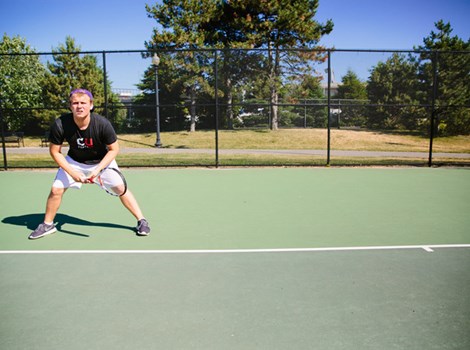

Tennis: Types Of Grips

Whether you are picking up the sport or have been playing your entire life, one thing that all tennis players continuously focus on is mastering the different types of grips. When referring to a grip in tennis, your grip is not what the handle of the racquet is made of or the material of the overgrip on the racquet. Instead, it is the way which atennis player positions their hand to hold the racquet. The different grips affect the way you hit the ball, the direction of the ball, the pace, spin, and where you make contact with the ball on the court. For different strokes, tennis players must adjust their grip to the correct position to hit the perfect shot. Between serving, volleying, hitting ground strokes, and slicing, tennis coaches always focus on using the correct grip for each specific shot. Below is a brief overview of how each grip works and what shot it is used best with.
Key: When looking at the handle of a tennis racquet, the base has 8 edges which are referred to as "bevels". Reference the photo below when the different bevels are referred to for each grip, and make sure your base knuckle is in the right place.
CONTINENTAL GRIP:
Find the Grip: Put the base knuckle of your index finger on #1 to make a V-shape with your thumb and forefinger on top of the handle. If you are a lefty, put your knuckle on bevel #4.
Used For: Serves, volleys, overheads, slices, and defensive shots
Why use it? Allows for a explosive, versatile shot that puts less stress on your arm. When volleying, it provides an open racquet face for underspin and control. Most commonly used grip in tennis.
EASTERN FOREHAND GRIP:
Find the Grip: Put your hand flat against the strings and slide your hand down to the grip. Pretend you are shaking hands with the racquet (turn your hand clockwise). Your base knuckle should be on the right side of the racquet.
Used For: Learning how to hit a forehand.
Why use it? Allows a player to brush the back of the ball for topspin or flatten the ball out for more power. Great shot for fast reactions when coming to net.
SEMI-WESTERN FOREHAND GRIP:
Find the Grip: Move your knuckle one bevel clockwise from the eastern forehand grip to bevel #2 (counterclockwise for lefties)
Used For: Forehand
Why use it? Power, control, and topspin. Greater margin over the net.
WESTERN FOREHAND GRIP:
Find the Grip: For a full western grip, move your knuckle one more bevel clockwise from the semi-western grip. (counterclockwise for lefties)
Used For: Forehand
Why use it? Puts force and action on the ball. Enables a player to get tremendous topspin on the ball. Make sure you catch the ball higher so it does not drop into the net. This shot pushes your opponent back in the court behind the baseline.
EASTERN BACKHAND GRIP:
Find the Grip: From the continental grip, shift your knuckle one bevel counterclockwise (clockwise for lefties) so it is on top of the grip completely.
Used For: Backhands, Kick serve
Why use it? Provides stability in the wrist and allows a player to roll the ball with spin. Easy to transition into a volley.
EXTREME EASTERN/SEMI-WESTERN BACKHAND GRIP:
Find the Grip: Move the base knuckle of your index finger one bevel counterclockwise (clockwise for lefties) from the eastern backhand
Used For: Backhand
Why use it? Closes the racquet face so that you can strike the ball higher and farther in front of you. Powerful topspin return.
TWO-HANDED BACKHAND GRIP:
Find the Grip: Have your dominant hand with a continental grip and your non-dominant hand above it in a semi-western forehand grip. (Right Handed Players: right hand at bevel #1, left at bevel #3// Left Handed Players: left hand at bevel #4, right hand at bevel #2)
Used For: Backhand
Why use it? Great for return of serve and low shots. Provides extra power for balls at shoulder level.






